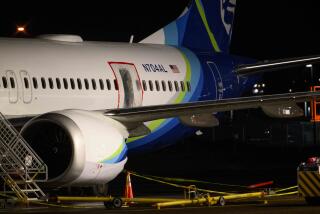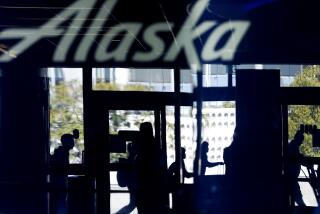Airbus ratchets up competition
Nearly a decade in the making -- and two years behind schedule -- the world’s largest jetliner made its commercial debut Thursday, flying from Singapore to Sydney with more than 450 passengers aboard. Some of them wore T-shirts that read “I did it on the A380” or “I’m first to fly A380.”
For Boeing Co., it was the gauntlet. The flight of Airbus’ Megaliner kicked off a new round in the multibillion-dollar contest between the rivals to be the one that sets the agenda for long-distance air travel.
European aircraft maker Airbus has bet the farm on the massive A380, which has a price tag of about $300 million each and if equipped entirely with coach seating could carry an unprecedented 850 passengers. Airbus is convinced that as major airports around the world become more congested, the answer for airlines will be an extremely large plane that can carry more people than two new 787 Dreamliners, on which rival Boeing has put its money. Boeing is betting that airlines will favor its 250-seat plane as they increasingly opt to avoid the likes of Los Angeles International Airport and lease more gates at smaller airports such as Burbank and Long Beach.
Airbus and Boeing “have a different view of the world,” said Richard Aboulafia, an aerospace analyst with Teal Group Corp. “We’ll see who’s right.”
For Kris Trexler, a film editor from Los Angeles who boarded the double-decker A380 in Singapore with a high-definition video camera, there was no question as to the answer.
“This is aviation history,” said Trexler as he filmed flight attendants pouring gratis Dom Perignon champagne. “This is the best, most exciting flight of my life, and I’ve been on a lot.”
Some of Trexler’s fellow passengers paid handsomely to make history on Singapore Airlines Flight 380. The carrier auctioned tickets on EBay, with proceeds going to charities in Australia and Singapore, and a Sydney businessman bid $100,380 for two of the 12 “luxury suites.”
Kelly Daoud, a corporate travel agent from Palm Springs, got off cheap by comparison, paying just $10,100 for his suite, which had sliding privacy doors, a fold-down full-size bed and a 23-inch video display.
“I’ll never have the opportunity to have a wine like this,” he said, sipping a glass of 1982 Chateau Cos d’Estournel. “I’m going to be in debt for a few years, but it’s worth it. My friends said I was crazy, but I think they’re jealous now. How can anyone top this?”
Trexler won his place in coach with a bid of $1,025, but any price would have been a bargain for him. The night before takeoff, he couldn’t sleep, he said. “This is as close to a memory of a lifetime as it’ll get.”
In Singapore, passengers began to arrive at the airport at 4:30 a.m., anticipating long lines, but the average wait for check-in was 15 minutes and people breezed through security. At the gate, they were treated to a buffet of breakfast pastry and canapes as a string quartet played classical music.
With separate ramps for the main and upper decks, boarding took about 30 minutes -- the process was slowed by a line of airline executives who greeted and shook hands with every passenger.
The plane was configured for 399 people in economy class, 60 in business class and 12 in suites. There were 33 in the flight crew, including four pilots, for the flight of just over seven hours.
On the main deck, there were 10 seats in each row, with four in the middle and three on either side. In the narrower upper deck, eight seats took up an economy row, with four in the middle and two on either side. The business-class seats on the upper deck were arranged in pairs in three rows.
Of the 468 passengers, 75 were newspaper and TV reporters.
“I expected it to have a party atmosphere, but I didn’t expect all the media. It’s become a media circus,” said Dean Wood, a Miami resident who paid $15,000 for business-class seats for him and his wife, Stephanie Mogol-Wood, who grew up in Calabasas. The couple estimated that they had been interviewed 20 times.
Passengers snapped pictures of one another in various areas of the plane, including the spiral staircase in the rear and in the restrooms, some spacious enough for several people to squeeze in at one time.
“It’s like a freak show,” said Anthony MacKay, an Australian living in London who paid $12,500 for two business-class tickets.
Thomas Lee, who 37 years ago flew on the first commercial flight of the 747, said people back then were far more subdued, though that may have been because the first 747 developed engine trouble and the inaugural flight took place on a substitute.
Lee said the A380 ride seemed smoother than the 747. “I was surprised by how quiet it is,” he said.
Last week, when Singapore Airlines Chief Executive Chew Choon Seng took delivery of the A380, he called it “the new queen of the skies.” But whether the A380 will redefine air travel the way the 747 did won’t be known for a while.
To date, Boeing has sold more than 1,500 of its 747s, and it is the most profitable large plane ever built.
At this point in the Megaliner versus Dreamliner race, Boeing is ahead. It has sold more than 700 Dreamliners -- the first 787 will go into commercial service late next year -- and Airbus has orders for 165 Megaliners.
Airbus officials said they were expecting a second wave of orders with the start of regular commercial flights. Those will be mostly in Asia and Europe at first. Late next year, Qantas Airways will make its introductory A380 trip to LAX from Australia.
If the A380 performs well for the airlines, “it has a chance,” said Adam Pilarski, senior vice president of aviation research firm Avitas Inc. “It’s a big plane, but how many people are on a cruise ship? Not many people complain about that.”
In fact, Pilarski said he didn’t think the Megaliner was big enough, despite the fact that its wingspan is nearly the length of a football field.
Right now, he said, “it doesn’t have substantial advantage over the 747, but it will when it is stretched. When it carries 900 people, it will be great.”
Problems assembling the A380 drove up the development cost from an initial $12-billion estimate to nearly $20 billion. That led to a major shake-up at Airbus that included the ouster of several top executives.
Boeing’s 787 Dreamliner hasn’t been immune to problems. In an embarrassing setback, Boeing said this month that shortage of parts would delay the first delivery by six months.
For Singapore Airlines, the decision to fly the A380 on the Singapore-to-Sydney route was strategic. The airline has been in a battle with British Airways and Qantas to fly the lucrative route that connects travelers from Europe and Australia. Before jets, propeller planes from Europe had to make numerous stopovers to reach Australia. Because of the “hops” involved, the trip became known as the Kangaroo Route.
These days, a flight from London typically stops over in Singapore before proceeding to Australia, and vice versa. Singapore Airlines hopes the introduction of the A380 will help it lure passengers, particularly first- and business-class customers, away from competitors.
The test will come Sunday when the Megaliner enters regularly scheduled service that will require a landing, unloading of passengers, cleaning of the cabin, restocking of meals, refueling, loading of passengers and taking off -- all within 110 minutes -- on a daily basis.






